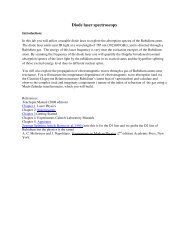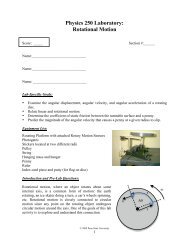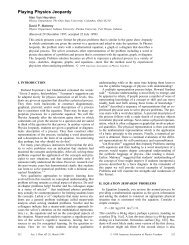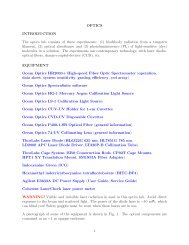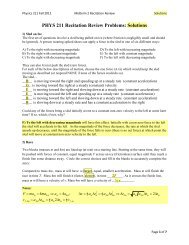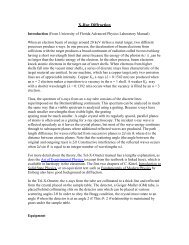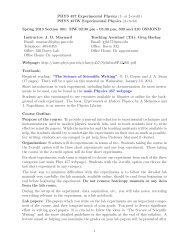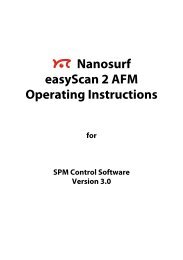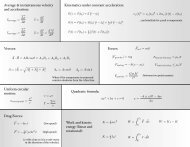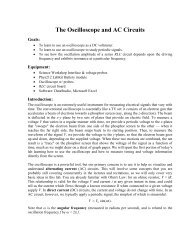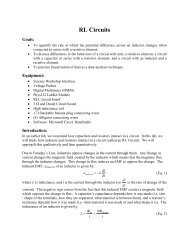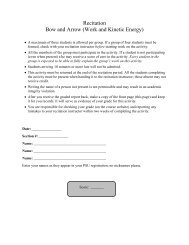Static Electricity (Lab 01)
Static Electricity (Lab 01)
Static Electricity (Lab 01)
Create successful ePaper yourself
Turn your PDF publications into a flip-book with our unique Google optimized e-Paper software.
Goals:<br />
<br />
<br />
<br />
<br />
<strong>Static</strong> <strong>Electricity</strong><br />
(Two Studies of Electrostatics)<br />
To become familiar with basic electrostatic phenomena<br />
To learn the charge model and learn to apply it to conductors and insulators<br />
To understand polarization and the attraction between neutral and charged objects<br />
To explore quantitatively how the electric force depends upon the distance between<br />
charged bodies.<br />
Equipment:<br />
<br />
<br />
<br />
<br />
<br />
<br />
<br />
Sticky tape (e.g. Scotch brand)<br />
PVC pipe<br />
Glass rod<br />
Wool cloth<br />
Rabbit fur<br />
Coulomb’s Law Apparatus<br />
Software: Microsoft Excel<br />
Introduction:<br />
Various civilizations have recorded observations of what we would typically call “static<br />
electricity” for thousands of years, dating back to the ancient Greeks and possibly even earlier.<br />
They noticed that when pieces of amber were rubbed or polished with animal fur, the amber<br />
could attract small bits of straw, even causing them to fly through the air to reach the amber. In<br />
the Elizabethan era, the English physician William Gilbert (1544–1603) first referred to this<br />
attraction as the “electric” attraction, deriving from the Greek word for amber, elektron. From<br />
these early beginnings, we have the modern words of electric, electricity, electrical, and so on.<br />
Gilbert was able to determine two “kinds” of electricity. In his terminology, amber, when rubbed<br />
with fur, acquires “resinous electricity” and when rubbed with silk, acquires “vitreous<br />
electricity.” He noted that pieces of amber with the same kind of electricity repelled each other<br />
and pieces with the opposite kind attracted each other.<br />
Years later, the American printer, author, philosopher, diplomat, inventor and scientist Benjamin<br />
Franklin (1706–1790) proposed that these two “kinds” of electric charge be named positive and<br />
negative, symbolized by (+) and (−), respectively. Franklin claimed that all materials possess a<br />
single kind of electrical “fluid” and that the action of rubbing one material against another did<br />
not create an electrical charge, but merely transferred some of this “fluid” from one body to the<br />
other. He presumed that neutral bodies consisted of equal numbers of positive and negative<br />
charges, and that rubbing transferred some positive charges from one body to another, leaving<br />
the first body with a net negative charged and the other with a net positive charge. He again<br />
confirmed that the same type of charges were found to repel each other while opposite charges<br />
were found to attract each other.
Through a very careful set of experiments involving a torsion balance and equally charged pith<br />
balls, the French engineer Charles Coulomb (1736–1806) was able to quantify the electric<br />
attraction and repulsion in the form we now call “Coulomb’s Law”. Coulomb’s law describes the<br />
force between two charged particles, labeled 1 and 2, and can be stated:<br />
1. If two point particles, having charges q 1 and q 2 respectively, are a distance r apart, the<br />
charges exert forces on each other with a magnitude of:<br />
q1<br />
q2<br />
F<br />
F<br />
<br />
k<br />
(Eq. 1)<br />
1on 2<br />
2 on 1<br />
2<br />
r<br />
These forces are equal in magnitude, but opposite in direction<br />
2. The forces are directed along the straight line drawn between the two charges. The forces<br />
are mutually attractive if the charges are opposite, and mutually repulsive for like<br />
charges.<br />
We will not repeat Coulomb’s experiment exactly, but we can make some qualitative<br />
observations using everyday items such as sticky tape, plastic pens, and metal keys, as well as<br />
some quantitative measurements with pith balls. With equipment as simple as this, we can repeat<br />
the same types of experiments that natural philosophers, inventors, and scientists have been<br />
performing for over 2400 years.<br />
Today, the process of rubbing two materials together to transfer some amount of electric charge<br />
is known as tribolectric charging. Table 1 below indicates the relative ability of a material to<br />
gain or lose charges due to rubbing. More plusses (+) next to a material in the chart indicates a<br />
greater ability to obtain a net positive charge. More minuses (−) next to a material in the chart<br />
indicates a greater ability to obtain a net negative charge.<br />
In general when two objects listed in the chart are rubbed together, the material listed higher in<br />
the chart becomes positively charged and the material listed lower in the chart becomes<br />
negatively charged (e.g., when rabbit fur is rubbed on glass, the fur will be positively charged,<br />
the glass negatively). The greater the separation of the materials in the chart, the greater the<br />
magnitude of the charge transferred.<br />
Material Relative charging with rubbing<br />
rabbit fur + + + + + +<br />
glass + + + + +<br />
human hair + + + +<br />
nylon/wool + + +<br />
silk + +<br />
paper +<br />
cotton<br />
−<br />
wood<br />
− −<br />
amber<br />
− − −<br />
rubber<br />
− − − −<br />
PVC<br />
− − − − −<br />
Teflon<br />
− − − − − −<br />
Table 1 Tribolectric charging
We can also characterize how easily charge can flow along or through a material. Materials that<br />
easily allow charge to flow through them are known as conductors. Materials through which<br />
charge cannot easily flow are known as insulators. We understand this distinction today in terms<br />
of the mobility of charge carriers within the material. For instance, in most metals (which are<br />
often good conductors), valence electrons are free to move anywhere throughout the metal, and<br />
thus can easily transfer charge from one location to another within the metal. In insulating<br />
materials, on the other hand, there are relatively few free charge carriers, and so excess charge<br />
tends to stay where it’s put on the surface of an insulator. At an atomic level, though, we can still<br />
envision a process by which the electrons orbiting their nuclei in an insulator can shift somewhat<br />
to the side due to external influences, a process known as polarization, and depicted in Figure 1.<br />
In the first portion of today’s experiment, you will explore the qualitative aspects of the<br />
electrostatic interaction between insulators, conductors, and differently charged objects.<br />
(a)<br />
(b)<br />
Figure 1 Depiction of polarization of an atom. In (a), a neutral atom is shown with dense, positively charged<br />
nucleus and a negatively charged electron “cloud” (depicted by the shading). In (b), when other charges are nearby,<br />
the electron cloud distorts due to electrostatic forces, and we say that the atom has become polarized (or<br />
equivalently, we say that a dipole moment has been induced). The distortion is greatly exaggerated here.<br />
In the second portion of today’s experiment, we will use the apparatus provided to verify<br />
quantitatively the inverse-square law dependence of Coulomb’s Law (Eq. 1). The general setup<br />
of this apparatus is depicted in Figure 2 below. A pith ball with a conductive coating is suspended<br />
by very light strings inside an enclosure which helps to limit the effects of stray air currents. In<br />
this portion of the experiment, you will charge both pith balls with the same type of charge, and<br />
hence they should repel each other. When both balls are at rest, we know that the system is in<br />
equilibrium, and so we can apply our knowledge of Newton’s 1 st Law and the geometry of the<br />
situation to help us relate the positions of the balls and the forces between them.<br />
Based on the free-body diagram presented for you in Figure 2, we can determine the net force in<br />
the x- and y-directions. When the system is in equilibrium, the net force in any direction should<br />
be zero. So, we can write:<br />
F 0 F T sin <br />
Rearranging this, we find:<br />
F<br />
x net<br />
y net<br />
e<br />
0 T cos mg<br />
T sin <br />
mg T cos <br />
If we divide the upper equation by the lower, we find:<br />
F e<br />
F e<br />
tan <br />
mg
T cos θ<br />
T <br />
T sin θ<br />
θ<br />
θ<br />
L<br />
F e<br />
x 1<br />
r<br />
x 2<br />
mg<br />
<br />
Figure 2 Schematic of Coulomb’s Law apparatus and associated free-body diagram for hanging mass.<br />
Finally, for the small angles which we will be dealing with in this experiment, we can use the<br />
small-angle approximation tan θ ≈ sin θ. From Figure 2, we can see that sin x<br />
2<br />
/ L . Thus,<br />
solving for the electric force F e , we find<br />
mg<br />
F e<br />
x 2<br />
. (Eq. 2)<br />
L<br />
If we could accurately measure the mass of the suspended ball, and the length of the string<br />
supporting it (and knowing the acceleration due to gravity at the surface of the earth, g), we<br />
could determine the electrostatic force F e by measuring the horizontal displacement of the<br />
suspended ball, x 2 . For our purposes, it will be sufficient to simply note that the electrostatic<br />
force is directly proportional to this horizontal displacement. According to Coulomb’s Law<br />
(Eq. 1) and the relationship we derived in Eq. 2, we can see:<br />
1<br />
F e<br />
or<br />
2<br />
r<br />
. (Eq. 3)<br />
1<br />
x2<br />
<br />
2<br />
( x2<br />
x1<br />
)<br />
The verification of this relationship will be our goal in Activity 2 of this lab.
Name: _Solutions___________________<br />
Name: ____________________________<br />
Name: ____________________________<br />
Date: ______________<br />
<strong>Lab</strong> Sect.: __________<br />
<strong>Lab</strong> Instructor: ______________________<br />
Directions:<br />
Note: If you are not careful while handling the materials in the activity, you may obtain<br />
inconsistent results. Please follow the directions as faithfully as possible! Also, do not throw out<br />
empty tape dispensers; we can refill them so other students can use them.<br />
Activity 1: Exploring static electricity qualitatively with sticky tape<br />
The following experiments will need you to use strips of tape that are about 20 cm long. Each<br />
time you are asked to use a strip of tape, fold over one end to form a non-sticky handle for easy<br />
handling, as in Figure 3.<br />
Figure 3 Preparing a strip of tape by making a non-stick handle<br />
Stick a 20-cm strip of tape on the lab table, sticky side down. This tape forms a standard base or<br />
“B-strip.” Stick another strip of tape on top of this one, smoothing it down well with your thumb<br />
and fingers. Using a pen or marker, label the handle of this strip with a “T” (for “Top” – this strip<br />
is referred to as a T-strip for the remainder of the lab). With a quick motion, peel off the T-strip<br />
from the base strip. Test whether this T-strip is attracted to your finger – if it is not, remake the<br />
tape. Once you know how to make a T-strip, prepare two such strips.<br />
Holding each one by the handle, bring the slick (non-sticky) sides of the two strips toward each<br />
other. Observe what happens, noting how the behavior changes with the distance between the<br />
strips.<br />
Q1. Describe and explain what happens as the two T-strips are brought closer together.<br />
The T-strips repel as they are brought close together<br />
Q2. What qualitative conclusions can you draw about the relationship between electric force<br />
and the distance between charges? How do your observations relate to Coulomb’s Law?<br />
The closer they are brought together the more strongly they repel. This makes sense since C’s<br />
Law says the force they feel should go like 1/r 2
Q3. Can you tell from your experiment so far whether the T-strips carry a positive charge or a<br />
negative charge? Briefly explain your answer.<br />
We can’t tell whether they are positive or negative from this experiment, merely that they have<br />
the same sign of charge.<br />
Q4. Using the additional equipment that has been supplied to you (the PVC pipe, glass rod, wool<br />
cloth, and rabbit fur) and the information in Table 1, design and carry out an experiment that<br />
allows you to determine the sign of the charge on the T-strips. Describe your experiment and its<br />
results.<br />
If we rub PVC with rabbit fur then the PVC will become negatively charged. We can then test<br />
to see if the T-strips are attracted or repelled by the PVC. If they are attracted then they are<br />
positively charged; if repelled they are negative.<br />
Conclusion: T-tape is attracted to the PVC so positive<br />
Examining a “B” strip<br />
Place another base strip on the lab table as before. This time, use a marker or pen to label the<br />
handle “B” (for "Bottom"). Press another strip of tape on top of the B-strip, sticky side down;<br />
label the handle “T”. Make sure the two strips have stuck to each other smoothly. Now, remove<br />
the pair of strips from the table. Check whether the pair of strips is attracted to your finger – if<br />
you do see an attraction, have one of your teammates rub the slick side of the tape with their<br />
fingers or thumb. This is important: by rubbing your finger along the pair, you discharge the<br />
pair, ensuring that the pair of tape strips is neutral.<br />
Once you have made certain the pair of strips is neutral, peel the pair apart to get a separate T-<br />
strip and B-strip. Let someone else in your team make another pair of B and T strips in the same<br />
manner. As before, your aim is to study the interaction between these different strips by bringing<br />
the slick sides towards each other.
Q5. Summarize the interactions between two T-strips, between two B-strips and between a T-<br />
strip and a B-strip.<br />
T-T interaction: (a) no interaction (b) they attract (c) they repel<br />
B-B interaction: (a) no interaction (b) they attract (c) they repel<br />
T-B interaction: (a) no interaction (b) they attract (c) they repel<br />
Q6. In Q4, you determined the sign of charge on the T-strip. Based on that sign, and the<br />
interactions above, what is the sign of the B-strip? Describe how you could use the same method<br />
you described in Q4 to verify the sign of the B-strip, and do so.<br />
It seems likely that B is negatively charged (opposite sign of T). It isn’t neutral because it repels<br />
the other B.<br />
We can try to confirm by seeing if it is repelled by the negatively charged PVC<br />
Q7. Given that you made certain that the pair of tape strips was neutral before separating the<br />
strips, is it possible to create a T-strip and B-strip that repel each other? Explain why or why not.<br />
No. To repel they must have the same sign of charge, which would require a net charge.
Testing charged strips with conductors and insulators<br />
Make another pair of T and B strips. Suspend them from the edge of the table as shown in Figure<br />
4 below.<br />
T<br />
B<br />
Figure 4 Hanging T-strip and B-strip from edge of table<br />
Hold a conductor (e.g. a metallic object such as a key) near each tape and observe what happens.<br />
(Make sure that you do not allow the conductor to touch the tape.)<br />
Q8. Describe the interaction between the conductor and each strip.<br />
Conductor/T-strip interaction: (a) no interaction (b) they attract (c) they repel<br />
Conductor/B-strip interaction: (a) no interaction (b) they attract (c) they repel<br />
Q9. Using a few sentences and a clear sketch, explain these observations. Your sketch should<br />
show how the different charges in the conductor (i.e., electrons & protons) are distributed when<br />
the conductor is far away from a charged tape strip and when it is close to a charged tape strip.<br />
The charges in the conductor are free to redistribute. When the positively charged T-strip<br />
is brought near the neutral conductor, the conductor polarizes and then attracts the T-strip.<br />
Sketch:
Now, hold an insulator (e.g. the end of a plastic pen or the glass rod, provided that it has been<br />
discharged) near each tape and observe what happens. (Make sure that you do not allow the<br />
insulator to touch the tape.)<br />
Q10. Describe the interaction between the insulator and each strip.<br />
Insulator/T-strip interaction: (a) no interaction (b) they attract (c) they repel<br />
Insulator/B-strip interaction: (a) no interaction (b) they attract (c) they repel<br />
Q11. Using a few sentences and a clear sketch, explain these observations. Your sketch should<br />
show how the different charges in the insulator (i.e., electrons & protons) are distributed when<br />
the insulator is far away from a charged tape strip and when it is close to a charged tape strip.<br />
Though the electrons aren’t free to move in the insulator they are still free to shift, enabling a<br />
weak (compared to the conductor) polarization in the insulator<br />
Sketch:<br />
Q12. Based on your observations, which was stronger: the interaction between the conductor and<br />
the tape strips or the interaction between the insulator and the tape strips? Explain this<br />
observation.<br />
It was hard to see, but the conductor should more strongly attract the tape than the insulator
Activity 2: A quantitative study of Coulomb’s Law<br />
Now, we will set aside the sticky tape and turn our attention to the<br />
Coulomb’s Law apparatus. Our goal with this device is again to<br />
confirm that the electrostatic force between two charged bodies is<br />
inversely proportional to the square of the distance between them.<br />
For ease of calculation, we will adopt a horizontal coordinate<br />
system in which the original, undisturbed equilibrium position of the<br />
hanging ball is used as our origin. (See Figure 2 again for the<br />
geometry involved and Figure 5 for a depiction of our x-coordinate<br />
system.) Again, we will label the horizontal position of the blockmounted<br />
ball with respect to this origin as x 1 , and the horizontal<br />
position of the suspended ball as x 2 . It will not be easy to measure<br />
either x 1 or x 2 directly, but we can relate easy-to-make<br />
measurements to the ones we want.<br />
To begin, we will measure the position of the block-mounted ball by measuring the position of<br />
one end of the block itself. (Note: in the explanation which follows, it is assumed that you will be<br />
moving the block on the left-hand side of the apparatus.)<br />
d<br />
block<br />
X<br />
−x<br />
0<br />
+x<br />
block<br />
X 0<br />
Figure 5 Finding the block’s position when the block-mounted ball is just touching the suspended ball.<br />
1. Measure the diameter d of the block-mounted pith ball and record it below:<br />
Diameter of pith balls (d): _1.25 cm________________<br />
2. Touch both pith balls (the block-mounted ball and the suspended one) with your finger to<br />
ensure that both are neutral.<br />
3. Slide the block in its groove into the apparatus, so that the block-mounted ball just barely<br />
comes into contact with the suspended ball without displacing it (see Figure 5).
lock<br />
When the block is at this position (which we will call X<br />
0<br />
), we know that the block-mounted<br />
ball will be at position x 1 = −d (i.e., its center of mass will be one ball-diameter away from the<br />
center of mass of the suspended ball).<br />
4. With the block-mounted ball just barely touching the suspended ball, record the position of<br />
the block:<br />
“Zero” position of the block (<br />
block<br />
X<br />
0<br />
): ___________________________<br />
If we move the block farther to the left, the block-mounted ball’s position with respect to our<br />
origin will become more negative. If we move the block farther to the right, the ball’s position<br />
will become more positive. Using these notions, we can write down an expression for the blockmounted<br />
ball’s center-of-mass position (x 1 ) as a function of the block’s position measured via the<br />
block<br />
measuring tape ( X ) as<br />
block block<br />
x (<br />
X X ) . (Eq. 4)<br />
1 0<br />
d<br />
You should verify for yourself that this expression satisfies the conditions we just described. To<br />
summarize: we will record the block-mounted ball’s position by measuring the position of the<br />
block itself via the measuring tape provided on the outside of the apparatus.<br />
How do we determine the suspended ball’s position? At the back of the Coulomb’s law<br />
apparatus, a separate ruler is mounted below a mirror. If you try to line up the ball with the ruler<br />
at the back of the apparatus, you’ll notice that you can get drastically different position readings<br />
if you move your head left or right. This phenomenon is called parallax, and occurs anytime you<br />
try to compare the transverse positions of objects located different distances away from you. To<br />
help minimize the effect of the parallax, we can try to line up the edge of the ball directly with its<br />
reflection in the mirror. When we do this, we’re looking dead-on at the edge of the ball, and can<br />
trust our reading from the ruler at the back of the apparatus.<br />
So, to find the position of the suspended ball at any point in time, we just line up the edge of the<br />
ball with its reflection in the mirror, and look to see where this lines up with the ruler. This<br />
mirror<br />
position we can call X . When the ball is hanging straight down, we’ll say that its edge is at<br />
mirror<br />
position X<br />
0<br />
(which corresponds to the center of mass being at a position of x 2 = 0). From<br />
these considerations then, we find that the suspended sphere’s center-of-mass position (x 2 ) can be<br />
determined from the measurement with respect to the ruler at the back of the apparatus by<br />
mirror mirror<br />
x X . (Eq. 5)<br />
2<br />
X<br />
0<br />
5. Record the “zero” position of the edge of the suspended ball when it hangs vertically<br />
downward, as measured with the no-parallax method described above with respect to the<br />
ruler in the back of the apparatus.<br />
“Zero” position of edge of the suspended ball (<br />
mirror<br />
X<br />
0<br />
): ___________________________
To facilitate the analysis of the data, and to acclimatize you to using common software tools for<br />
this task, we have provided a spreadsheet with the necessary calculations (e.g. Eqs. 4 and 5)<br />
already provided. Take this opportunity to open the “<strong>Static</strong>_<strong>Electricity</strong>.xls” spreadsheet and enter<br />
block<br />
mirror<br />
your measurements for d, X<br />
0<br />
, and X<br />
0<br />
in the spaces provided. Thoroughly read the<br />
directions below on how to perform the experiment (Steps 6 through 11), and then collect your<br />
data in the Excel spreadsheet.<br />
6. Rub your PVC pipe vigorously with the rabbit fur provided to charge the pipe.<br />
7. Charge the block-mounted ball by induction. To do so, first move the block and ball away<br />
from the Coulomb’s Law apparatus. Bring the charged PVC pipe near, but not touching the<br />
block-mounted ball, to within a few centimeters distance. Touch the block-mounted ball with<br />
your finger. Remove your finger from the ball and then remove the PVC pipe from the<br />
vicinity of the ball. The block-mounted ball has now been charged by induction.<br />
8. Slide the block and ball back into the groove in the Coulomb’s Law apparatus (being careful<br />
to not let the ball come into contact with any surface.)<br />
9. Slowly move the block-mounted ball into the apparatus until you see the suspended ball<br />
swing toward it, touch it, and then rapidly swing away. At this point, both the block-mounted<br />
ball and the suspended ball are charged. Move the block-mounted ball 0.5 cm back away<br />
from this position.<br />
10. Slide the block farther into the apparatus as far as you can (but not so far as to push the<br />
block-mounted ball into the suspended ball again; they should still be separated by some<br />
distance.)<br />
11. Humidity in the air and stray air currents will gradually discharge your spheres, so it best to<br />
work quickly. Using the Excel spreadsheet provided, record the positions of the block and the<br />
suspended ball as you slide the block in 2- or 3-mm increments back out of the apparatus.<br />
Take at least 10 or so readings.<br />
Once you have collected your data, proceed with the analysis by answering the following<br />
questions and providing graphs of your data where requested.
Q13. In step 7 of the procedure, you charged the block-mounted ball by induction. Sketch the<br />
distribution of charges (i.e. protons and electrons) on the pith ball, your finger, and the PVC pipe<br />
when (a) you’ve just brought the PVC pipe near the ball, (b), you’ve just touched your finger to<br />
the ball, (c) you remove your finger, and (d) when you move the PVC pipe away from the ball.<br />
(a) PVC brought near to ball<br />
(b) Finger touches ball<br />
(c) Finger moves away from ball<br />
(b) PVC moved away from ball<br />
Q14. In step 9 of the procedure, you charged the suspended ball by conduction. Sketch the net<br />
distribution of charges (i.e. protons and electrons) on both balls, shortly before they touch, at the<br />
moment they touch, and after the suspended ball has swung away.<br />
(a) Block-mounted ball attracts suspended ball<br />
(b) Both balls touch<br />
(c) Suspended ball has swung away
12. You should now attempt to verify (Eq. 3) (the statement that the electrostatic force between<br />
two charged point particles is inversely proportional to the square of the distance between the<br />
charges). To do so, create a plot of the force versus distance (F e vs. r). Include a copy of this<br />
plot in your lab report.<br />
Q15. Does your plot of force versus distance support the statement that the electrostatic force is<br />
inversely proportional to the square of the distance between the charges? Can you quantify to<br />
what extent the data fits or fails to fit this model?<br />
13. We now wish to “linearize” our data by plotting the force versus the inverse of the distance<br />
squared (F e vs. 1/r 2 ). In your Excel file, create a new column of 1/r 2 . Create a plot of force<br />
versus the inverse of the distance squared, and add a linear trendline in order to quantify the<br />
extent to which your data fits the prescribed model (Eq. 3). Include a copy of this plot in your<br />
lab report.<br />
Q16. Is it easier to confirm or deny the relationship described in Eq. 3 via this plot than it was<br />
with the plot of F e vs. r? Why?



